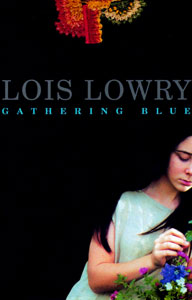Literary Guide for Lois Lowry’s “Gathering Blue”
Gathering Blue by Lois Lowry

Designed for use with readers at a 5th grade level, our literature guide for Lois Lowry’s Gathering Blue offers families support in adding insight, visualization, and even mastery of a new skill to a great summer read!
Looking for ways to enhance family reading time? Summer is the perfect time to explore books as a family, and to expand stories and create opportunities for deeper learning together. Hilltown Families offers a wealth of resources for supporting families in this endeavor, beginning with the very first featured title in our 2015 Summer Reading Resource series of literary guides!
Featured weekly throughout the summer, this year’s installments in the annual Summer Reading Resource series include downloadable guides to children’s literature written by students and alumni from the Integrated Learning teacher preparation program at Antioch University New England. Each literary guide pairs a featured book with suggestions for ways to help children expand their thinking, create connections to the text, and allow their literacy skills to grow. These guides contain outlines with discussion topics, critical thinking questions, and suggestions for many other activities that can provide supplemental education at home. The titles featured throughout the summer will cover a wide range of genres, themes, and reading levels, so as to provide something for everyone and to support families in their pursuit of new and fascinating reading material.
The books included in the series include both picture and chapter books, and cover all of the ages and developmental capacities typically found in grades K-6. Check back weekly for a new guide, or peruse the resources offered in our 2013 and 2014.
The first guide in this summer’s series is Gathering Blue, written by literary great, Lois Lowry.
The book Gathering Blue, the second installment of Lowry’s Giver Quartet (though it can be understood without context provided by The Giver), combines fiction and fantasy with threads of reality in order to tell a story that is both far from home and close to it. Set in a fictional community, the book shares the story of Kira’s struggles – which stem from her deformed leg and the fact that her community normally abandons the weak or disabled. The community in which the story takes place is fictional, but seems inspired by our true past and present – though the culture in which Kira lives is a far cry from the culture in which we live today. Kira’s job within her community is to dye thread and to weave, and despite her fantastic talent for both of these tasks, she lives somewhat outside of the rest of her community. As the story progresses, Kira makes discoveries about her past and her community that make it quite evident to her that things are not quite as she has been taught to see them – a realization that leads Kira to drastically change her sense of self, as well as her life path.
While Gathering Blue is not set in any specified time period, it is implied that the story takes place in some distant future era, as elements of the natural and human worlds described are similar to things we see and experience today. While reading the story, families should take note of such similarities, as observations of the connections between our reality and Kira’s can make for some important discoveries. Other topics to consider while reading Gathering Blue include the treatment of the disabled, women’s rights, the value of talent, and the intersection of knowledge and power (see the literary guide for suggestions on facilitating discussion of these topics).
As Gathering Blue takes place in a setting that is truly foreign to all readers, descriptive language plays an important role in the text. Conscious creation of mental imagery while reading the text can support older readers in deepening their comprehension of the specific descriptive language of the text. Additional opportunities for learning come from expanding upon topics that arise within the story – specifically, the art of weaving and dyeing, wood carving, embroidery, sewing, or basket making. Exploring the rich cultural history behind each of these traditional skills can help young readers understand each one within a real world context and, with support and proper materials, experimentation with the skills specific to each art would provide even deeper learning opportunities. Practicing (and perhaps perfecting) one of the skills that is central to the book’s plot could help readers connect with the characters who engage in each skill and whose lives are dictated by their ability to perform. And, on top of supporting literacy skills, learning any of these arts can help to support fine motor skills and provide an outlet for unique creativity.
Using the accompanying literary guide, families can explore these topics and engage in deep, thoughtful discussion of the themes included in the story. Though the guide has been written for use within a 5th grade classroom, activities can be easily adapted for use at home and are accessible to readers of any age who are able to comprehend the story. After you’ve read Gathering Blue, finish the series by reading Messenger and Son, too!
- Download Literary Guide for Gathering Blue
 Hilltown Families
Hilltown Families 





























